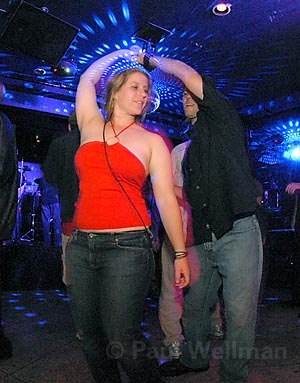
“You can dance if you want to.” That’s the message the Santa Barbara City Council gave patrons of Sandbar by turning down an appeal and approving a dance permit for the State Street club Tuesday. The approval brings the grand total of dance permits for the State Street entertainment district to 21, out of a citywide total of 25.
The district-from the beach to Sola Street and from Chapala to Santa Barbara streets-is being maxed out by alcohol-serving establishments, permit opponents said. And it’s already the most highly concentrated area for alcohol establishments in the state, according to police. But nonetheless the council denied an appeal from Tamara Erickson-manager of State Street’s Hotel Santa Barbara-and Kay Morter, general manager of Holiday Inn Express Hotel Virginia on Haley Street. The unanimous decision upheld a Fire and Police Commission decision to grant a dance permit to Old Town Hospitality LLC, for Sandbar, at 514 State Street.
In the last eight months, 77 percent of cited crime in the 400-900 blocks of State Street occurred between the 400 and 600 blocks, with the 500 block alone generating 38 percent. The entertainment district is the most heavily policed area of the city, and over the last three years, 70 percent of the city’s alcohol-related offenses occurred there. But the issue is not dancing; the main concern is the offspring of careless alcohol consumption, most at the meeting agreed. Many who spoke up against allowing the permit cited late-night loud music from the clubs, as well as drunken patrons fighting, urinating, vomiting, and engaging in other unsightly and disrespectful activities as reasons to keep Sandbar from getting a permit. But no one referred to dancing as a reason.
A dance permit doesn’t change the noise level at all, nor does it change the amount of alcohol consumed, the council said. As Councilmember Das Williams put it, the city “should not use dancing as a proxy to vilify other problems in the city.” Many people drink without dancing and dance without drinking, he said.
So why a dance permit at all? The city, though it can offer an opinion, has no control over who receives licenses from the ABC (Alcoholic Beverage Control), so it uses the dance permit as a way to modify behavior. Sandbar will have the “strictest conditions put on a dance permit to date,” according to city staff. Conditions include a certain number of security guards, keeping windows and doors closed during certain hours, and no audible music beyond 50 feet from the premises.
Sandbar doesn’t need a dance permit to attract business, said Ron Newman, who took over ownership of the club in September. Three of Newman’s Sharkeez establishments in Southern California don’t have dancing and remain quite busy. But if the majority of alcohol-serving venues on the same block have dancing, then Sandbar needs dancing to stay competitive.
If the council had not approved the permit, Newman’s purchase would’ve been revoked, he said. It remains in escrow until permanent permitting is in place. Noise and security problems associated with Sandbar during its prior ownership led police to check on how the new owners were running the establishment. There have been only seven calls for service in the six months of operation since the changing of the guard, five of which were initiated by Sandbar management. “It seems to me the new operators have a track record in making improvements,” Councilmember Roger Horton said.
Meanwhile, one of Santa Barbara’s older drinking establishments, Mel’s, is still awaiting a hearing date from the ABC. Rent at Paseo Nuevo has gone “through the roof,” according to owner Michael Knapp. Thus, Mel’s is looking to move to the 400 block of State Street. Santa Barbara police aren’t terribly thrilled about the possible move and have even written a letter to the ABC opposing it. The differences between Mel’s and Sandbar are that the latter is already a bar, as opposed to a whole new establishment coming to the block, and that Mel’s only serves alcohol.
But Knapp argues that it wouldn’t be a new bar opening, but merely an old one moving just a few blocks. That, combined with the fact that Mel’s has an extremely small number of complaint calls, should be reason enough to allow the move, he said. If it did move, Mel’s would be outfitted with the necessary security cameras, lights, and security detail to “cover the bases.” And if it doesn’t, Knapp said the longtime Santa Barbara bar will probably shut down.



